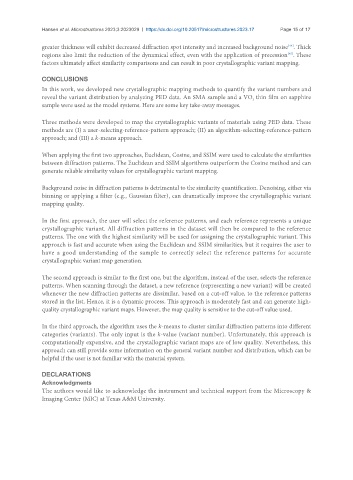Page 37 - Read Online
P. 37
Hansen et al. Microstructures 2023;3:2023029 https://dx.doi.org/10.20517/microstructures.2023.17 Page 15 of 17
[44]
greater thickness will exhibit decreased diffraction spot intensity and increased background noise . Thick
[45]
regions also limit the reduction of the dynamical effect, even with the application of precession . These
factors ultimately affect similarity comparisons and can result in poor crystallographic variant mapping.
CONCLUSIONS
In this work, we developed new crystallographic mapping methods to quantify the variant numbers and
reveal the variant distribution by analyzing PED data. An SMA sample and a VO thin film on sapphire
2
sample were used as the model systems. Here are some key take-away messages.
Three methods were developed to map the crystallographic variants of materials using PED data. These
methods are (I) a user-selecting-reference-pattern approach; (II) an algorithm-selecting-reference-pattern
approach; and (III) a k-means approach.
When applying the first two approaches, Euclidean, Cosine, and SSIM were used to calculate the similarities
between diffraction patterns. The Euclidean and SSIM algorithms outperform the Cosine method and can
generate reliable similarity values for crystallographic variant mapping.
Background noise in diffraction patterns is detrimental to the similarity quantification. Denoising, either via
binning or applying a filter (e.g., Gaussian filter), can dramatically improve the crystallographic variant
mapping quality.
In the first approach, the user will select the reference patterns, and each reference represents a unique
crystallographic variant. All diffraction patterns in the dataset will then be compared to the reference
patterns. The one with the highest similarity will be used for assigning the crystallographic variant. This
approach is fast and accurate when using the Euclidean and SSIM similarities, but it requires the user to
have a good understanding of the sample to correctly select the reference patterns for accurate
crystallographic variant map generation.
The second approach is similar to the first one, but the algorithm, instead of the user, selects the reference
patterns. When scanning through the dataset, a new reference (representing a new variant) will be created
whenever the new diffraction patterns are dissimilar, based on a cut-off value, to the reference patterns
stored in the list. Hence, it is a dynamic process. This approach is moderately fast and can generate high-
quality crystallographic variant maps. However, the map quality is sensitive to the cut-off value used.
In the third approach, the algorithm uses the k-means to cluster similar diffraction patterns into different
categories (variants). The only input is the k-value (variant number). Unfortunately, this approach is
computationally expensive, and the crystallographic variant maps are of low quality. Nevertheless, this
approach can still provide some information on the general variant number and distribution, which can be
helpful if the user is not familiar with the material system.
DECLARATIONS
Acknowledgments
The authors would like to acknowledge the instrument and technical support from the Microscopy &
Imaging Center (MIC) at Texas A&M University.

